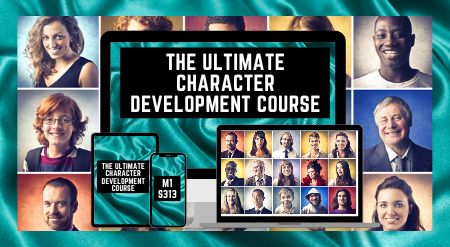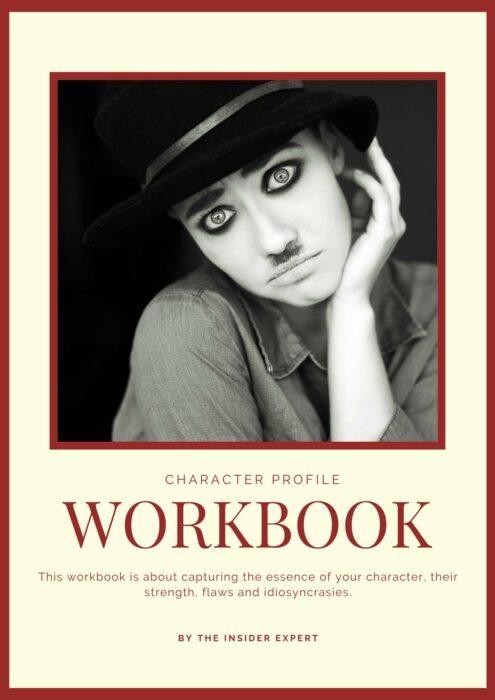SAMPLING FROM: The Ultimate Character Development Course

This is a sampling of the content in The Ultimate Character Development Course (M1-S313)
TOPIC: How to create a character PROFILE and BACKSTORY
Characters really make a difference in both fiction and non-fiction. You’re trying to get a feel for that person, highlighting what makes them unique, their little quirks, and even their weaknesses. This is what really draws you into your story.
Characters are the part that readers really connect with. The quality of the writing often comes down to this element. Successful authors really understand how to create a character that sticks in the reader’s mind.
In this lesson, we’re going to dive into how to create a character profile and build a background that connects your character to their current situation.
The Importance of creating a a character profile and backstory
For fiction writers, profiles and backstories keep characters believable and consistent; for non-fiction writers, they bring truth to life by grounding facts in human experience. In both cases, they give the reader a reason to care.
For Fiction Writers
Building a character profile and backstory is really essential for great storytelling.
- A profile gives you the basics—like name, age, physical traits, little quirks, values, and habits.
- While the backstory dives into the history that made the character who they are at the start of the story.
If we don’t have these, characters might end up feeling flat, unbelievable, or just inconsistent.
-
It ensures characters act in ways that feel authentic and not forced by the plot.
-
It helps you maintain consistency in appearance, speech, and behaviour.
-
It provides depth, allowing readers to see motivations that stretch beyond the immediate story.
-
It prevents cliché by giving each character unique experiences and perspectives.
-
It makes dialogue sharper because you know what a character would or would not say.
-
In drafting: guiding how your characters respond to conflict, temptation, or opportunity.
-
In revising: checking whether actions align with established traits and history.
-
In world-building: linking your characters’ personal histories with larger events in your fictional setting.
-
In marketing: using your character profiles in blurbs, websites, or bonus content for readers who enjoy knowing more.
For Non-Fiction Writers
Even though non-fiction focuses on real people, having character profiles and backstories can be just as important. When you’re diving into biography, memoir, history, or narrative non-fiction, it’s all about really getting to know who a person is and where they come from. This connection helps readers see them as real people instead of abstract names or statistics.
- It humanises historical figures, case study subjects, or memoir narrators.
- It explains why individuals made particular choices within their society or context.
- It helps readers empathise, even when they may not agree with someone’s decisions.
- It provides narrative drive: readers follow lives, not just events.
- It adds credibility, showing that your interpretation is rooted in real evidence.
- In biographies: developing full portraits of the people you are writing about.
- In memoirs: ensuring your own voice is consistent and grounded in your lived experience.
- In history books: helping readers grasp the impact of events by showing them through individual lives.
- In case studies or journalism: presenting subjects as complex individuals rather than faceless examples.
- In teaching or self-help non-fiction: illustrating ideas through vivid, personal backstories that readers remember.
Questions to Ask Yourself that May Help

Questions for Fiction Writers – Character Profiles & Backstories
-
What is the character’s full name, and does it have any special meaning?
-
How old are they at the start of the story?
-
What do they look like (height, build, eye colour, scars, mannerisms)?
-
How do they dress, and what does it say about them?
-
Do they have a nickname, and who uses it?
-
Where were they born?
-
What kind of family did they grow up in?
-
What was their childhood like—happy, troubled, or ordinary?
-
Did they experience any formative trauma or joy?
-
What education did they receive?
-
What was their social class or financial situation growing up?
-
Who were the most influential people in their past?
-
What cultural or religious traditions shaped them?
-
Have they moved often, or lived mostly in one place?
-
What skills or talents did they develop early in life?
-
Who are their family members now, and how do they get along?
-
Do they have close friends, and what binds them together?
-
What romantic experiences have shaped them?
-
Who do they trust most, and who do they mistrust?
-
Do they have rivals, enemies, or people they resent?
-
What is their greatest strength?
-
What is their greatest flaw?
-
What are their fears?
-
What motivates them—love, ambition, revenge, curiosity?
-
Do they live by any personal code or philosophy?
-
Are they introverted or extroverted?
-
What makes them laugh, and what makes them angry?
-
Do they see themselves as a hero, a victim, or something else?
-
How do they cope under stress?
-
How do they treat people weaker than themselves?
-
What do they want most at the start of the story?
-
What obstacles stand in their way?
-
How does their past influence current goals?
-
Do they change their goals as the story progresses?
-
What would they sacrifice to succeed?
-
Do they have hobbies or passions outside the plot?
-
Do they drink, smoke, or have addictions?
-
How do they spend their spare time?
-
What is their daily routine?
-
Do they have quirks that make them memorable?
-
How does their backstory link with the central theme?
-
How do they interact with the story’s setting?
-
How does their history drive the main conflict?
-
What secrets from their past affect the present?
-
How much of their backstory is revealed to the reader, and when?
-
Does their arc involve overcoming or embracing their past?
-
How do they surprise the reader?
-
How do they surprise themselves?
-
What would their life look like without the central conflict?
-
How do they change from beginning to end?
Questions for Non-Fiction Writers – Character Profiles & Backstories
(For biographies, memoirs, history, journalism, or case studies.)
- What is the person’s full name, and does it have cultural or family significance?
- When and where were they born?
- What did their early environment look like?
- What was their social class or economic status?
- How would others have described them in youth?
- Who were their parents, and what were their roles?
- Did they grow up with siblings, and how did these relationships shape them?
- What kind of education did they receive?
- Did their childhood include hardship, privilege, or both?
- Were there key family traditions or values passed down?
- What early successes shaped their confidence?
- What early failures shaped their resilience?
- Did they experience loss or trauma in formative years?
- Were there pivotal mentors or role models in their youth?
- What historical events framed their early life?
- How did they begin their professional journey?
- What obstacles did they face in their career?
- What key achievements defined them publicly?
- How did society view their work or contributions?
- Did their career choices align with or oppose their upbringing?
- Who were the most important personal relationships in their life?
- Did they have children, and how did parenthood affect them?
- How did friendships and networks influence their opportunities?
- Did they form alliances or rivalries of significance?
- Who opposed them, and why?
- What values or beliefs guided their decisions?
- Were they known for particular habits or quirks?
- How did they deal with conflict?
- What were their greatest fears?
- What did they most desire in life?
- How did they respond to public pressure or criticism?
- Did they have a strong faith, philosophy, or ideology?
- Were they private or open in sharing their emotions?
- How did their personality evolve over time?
- How do those who knew them personally describe them?
- How did the society of their time shape their opportunities?
- Did they challenge or conform to social expectations?
- How were they affected by political, cultural, or economic changes?
- Did they face prejudice, privilege, or both?
- How did they leave their mark on their society?
-
What lessons can be drawn from their life?
-
How did their backstory shape their legacy?
-
Are there myths or misconceptions about them?
-
What did they regret, if anything?
-
How did they want to be remembered?
-
What impact did they have on those closest to them?
-
What impact did they have on their field or community?
-
How does their story inspire or warn modern readers?
-
What sources confirm or challenge details of their backstory?
-
How can the writer portray them truthfully, while also compellingly?
PDF Workbook Instructions

Download your PDF workbook and save it to your a folder you have created on your computer specifically for saving your ideas, so you can refer to it again and again.
This interactive PDF workbook provides a convenient platform for directly typing and organising your ideas.
Open the interactive PDF workbook in a PDF viewer and type your answers in.
You can print your PDF workbook out (be sure to select· scale size to fit your printer setting) and place them into your ideas binder.
Open the interactive PDF workbook in a PDF viewer and type your answers in.
Want More
Are you interested in learning more after giving the sampling a go? Are you looking to pick up some new skills and figure out how to grab your readers’ attention with your characters and make them truly memorable?

The Ultimate Character Development Course (M1-A313)
If you’re after a more focused learning experience, this option could be just what you need. Characters really connect with readers when they express their human emotions in a relatable way. The most interesting characters really demonstrate how they see the world just like we do as humans.
In this course, you’ll dive into creating characters that really grab attention. You’ll explore their flaws, character arcs, profiles, backstories, strengths, and weaknesses. You’ll also get a better understanding of the various emotional triggers and character types. You’ll get 13 lessons to learn at your own pace, and you can go back and review the material as often as you need to really grasp the concepts.
This course comes with some great handbooks like 175 Character Types, Character Strengths, and Weaknesses. We dive into the emotional triggers that influence your character’s behaviour and explore what really makes a character resonate with your readers.
